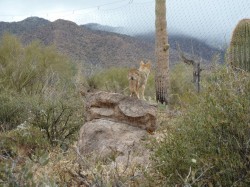“That animal is just lying there with nothing to do!” a woman at the zoo where I once volunteered griped, head shaking in disgust.
The Siberian tiger she viewed was, indeed, lying in his enclosure, sound asleep. Whether or not he had access to his outdoor area was not evident. “He doesn’t have enough space and he’s bored!” the woman ranted.
“Things aren’t always what they seem,” I said as I approached her. “I’ve been monitoring his activity all morning – for at least three hours – for a research project. Until a bit ago, the female was in the enclosure with him, and I recorded them mating 28 times!” The tiger was certainly not bored, I told her. He was exhausted!
Natural Habitats
While many people enjoy visiting zoos and other facilities that harbor captive animals, some feel it is wrong and immoral to maintain animals away from their native habitat in spaces generally smaller than their wild counterparts inhabit. That certainly may have been true in years past, but today’s zoos, aquariums, and other facilities attempt to re-create environments where animals can flourish, as well as offering stimulation to prevent boredom.

After living on wildlife refuges for seven years, Chuck and I have grown to delight in spotting animals in the wild. Most animals are difficult to locate in wilderness areas and even in open spaces, making it more rewarding when one actually appears. However, wild animals face many hazards and difficulties that captive animals never encounter. Often, their lives are shortened by accidents, predation, starvation, diseases, natural catastrophes, or a multitude of other possibilities.
How Much Space?
Captive animals, on the other hand, do not face predators and they have continual access to the basic needs of life: food, shelter, water, and (for the most part) space. But how much space does an animal need?
[twocol_one]

[/twocol_one] [twocol_one_last]

[/twocol_one_last]
While visiting a reptile facility several years ago, we toured it with the curator. Stopping in front of an alligator snapping turtle exhibit, he reflected a bit. “We used to have a huge, very old – well over 100 years – alligator snapper,” he said. “We kept him in this exhibit. It’s just big enough for him to fit.” Visitors, the curator went on to explain, complained that the animal didn’t have enough space. They were outraged. “So even though we knew better,” the curator continued, “we moved him to a bigger exhibit to appease the crowds. He died shortly thereafter.”
A Siberian tiger may need over 300 square miles of space to maintain itself in the wild. A greater territory often means scarcity of food, making it more difficult to find prey. A small territory, on the other hand, usually indicates greater abundance. Most animals don’t roam for exercise; rather they go in search of food or mates.
Small Cages?
Once when our snakes were on display at a national wildlife refuge visitor center, a woman observed them with concern. “Their cages are too small,” she said. “They need more space!”
Having been trained by reptile zoo keepers in snake husbandry, Chuck takes pride in the care and attention he devotes to our snake collection. Annoyed by this visitor’s angry accusations, he asked, “How much space do you think they need?”
“Well,” she replied, “more than that!” Without realizing that these animals spend most of their time coiled in their hide boxes, this woman assumed they needed to slither about for recreation. But with food, water, and shelter readily available, along with basking lights to help digest their meals, caged reptiles and many other animals feel secure in their limited space. Their needs are met.
[twocol_one] [/twocol_one] [twocol_one_last]
[/twocol_one] [twocol_one_last]

Unlike years ago, the majority of today’s zoo animals have been born and raised in captivity and have never experienced hazards of the wild. And unlike years ago, much attention is paid to designing an enclosure that meets an animal’s needs, sometimes at the expense of esthetics, as long as it mimics an animal’s preferred habitat.
[twocol_one]

[/twocol_one] [twocol_one_last]

[/twocol_one_last]
Longer, Healthier Lives
While larger spaces please the viewing public, with few exceptions animals live longer and healthier lives in a captive situation, regardless of public perception.



